Menus
- 0 – 100 km / h in 3 seconds … Revolution…
- Revelation electric motor, 105 hp and 116.6 Nm, 249 kg, adjustable Showa suspensions, 150 km of range, from 33,900 euros
- Discovery
- In the saddle
- In the city
- Departmental
- Highway
- Part-cycle
- Braking
- Autonomy
- Video test
- Conclusion
- Pilot equipment
0 – 100 km / h in 3 seconds … Revolution…
Revelation electric motor, 105 hp and 116.6 Nm, 249 kg, adjustable Showa suspensions, 150 km of range, from 33,900 euros
Breakfast barely finished, the tables are cleared, the space quickly turns into a meeting place, under a huge white tent pitched in front of the parking lot of the Jupiter Hotel in Portland, USA. Harley-Davidson marketing manager Paul Butler climbs up a small wooden platform with a smile on his face. The atmosphere is friendly, no frills, the few HD specialists involved in the LiveWire project are seated by our side. Nothing to do with a presentation with great pomp, rather an informal presentation given by enthusiasts who know they are somewhat pioneers. It’s the case. Harley-Davidson presents the first mass-produced electric road motorcycle manufactured by a major brand, released in August. We might have expected an Apple-worthy event, fireworks, a gala evening…. No, the moment is intimate.
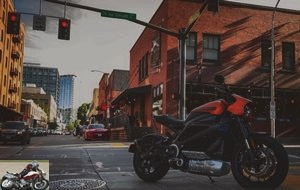 Harley-Davidson LiveWire review
Harley-Davidson LiveWire review
The LiveWire project began in 2010, a first prototype was tested on the site in 2014, the objective of the American brand had been declared for a while. Despite everything, the hour is historic. We were more likely to expect Honda or BMW in this kind of niche, but not a brand that awakens in everyone’s imagination an old school and traditional side of America, limited to customs and tumbled cast iron engines. 180 ° rotation, Harley clears a segment that everyone dreads. "We started off from scratch, of course," smiles Xavier Crepet, marketing director for the Southern Europe sector. We had to recruit new engineers, who we went to find in Silicon Valley, California. It was out of the question for them to move to Milwaukee, Harley’s headquarters. So we opened a factory in California…. ".
At the same time, Paul Butler’s presentation comes at the LiveWire rate, 33,900 euros. Colossal, obviously, even if we pay for development, even if this Harley will only sell at very low volumes and for good reason…. It continues on autonomy, between 150 and 200 km depending on use. Then recharging: 8 hours on a standard household outlet, 1 hour in DC Fast Charge…. available only at the concessionaire (thirteen will be available this year in France, out of the fifty-six in the network).
 The Harley-Davidson LiveWire
The Harley-Davidson LiveWire
Almost 34,000 euros for a motorcycle capable of driving two hours maximum, that’s crazy. If the Zero SR / F costs 13,000 euros less, that’s still crazy. Who would put more than 20,000 euros for this kind of bike? Without knowing how it will age, it will be possible to resell it for a good price etc. The car manufacturer Tesla promises reliability of the order of a million kilometers and it is true that a Tesla Model S has just passed 900,000 km (the longevity of a battery is measured in cycles but they can be converted approximately in kilometers). I finally admire the daring of Harley-Davidson, whose financial health is not at its best at the moment, to invest in this delicate market being certain of one thing, which is that it will not be profitable before long. But the former will gain an experience that the others will have to make up for. We can only praise this long-term vision then (even if we do not doubt for a second that the first buyers of LiveWire will surely be curious like Honda, Yamaha, BMW and others….). Besides, on the subject of renting, Harley has not – yet – developed a rental system like BMW does with its C-Evo scooter but the Harley financial service should offer it by the end of the year, with an initial contribution and 4 years of credit.
 The LiveWire is Harley-Davidson’s 1st electric motorcycle
The LiveWire is Harley-Davidson’s 1st electric motorcycle
Discovery
Glen Koval, the engineer overseeing the development of LiveWire, speaks up and speaks in a biker language that I can hardly read. “The lithium-ion battery cells (15.5 kW / h) are enclosed in a die-cast aluminum housing with cooling fins to dissipate heat. It is guaranteed for 5 years and its lifespan is estimated at 10 years. It powers the permanent magnet motor, named Revelation, which has a power of 78 kW, with a maximum speed of 15,000 rpm. This engine is water cooled. "Question marks galore, luckily Glen is popularizing it. “This power corresponds to approximately 105 horsepower. The torque is 116 Nm. ”Which makes it the most powerful Harley in production..
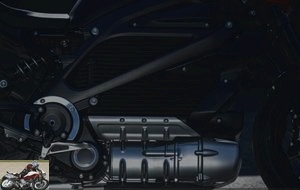 The Revelation engine delivers 105 hp and 116 Nm
The Revelation engine delivers 105 hp and 116 Nm
But, incorrigible, he puts it again: "Two types of charging are planned, the SAE J1772 Combo Inlet (CCS1) and IEC 62196 Combo Inlet (CCS2) for fast charging and a classic connector for household charging". ???? One for the 220V power outlet and the other for the DC Fast Charge fast charger. Ok. The rest is more digestible. It concerns the cycle part.
 The reloading socket located on the false tank
The reloading socket located on the false tank
The aluminum frame encloses as best it can the 95 kg battery placed above the engine. The bike remains thin, but the weight (249 kg) could be placed quite high. The length of the battery forced engineers to look for the shorter swingarm. The wheelbase is still 1490 mm long, roughly the equivalent of a Ducati 950 Hypermotard, or 4 cm longer than a Kawasaki Z 900. There is no gearbox, a shaft transmits power directly to the rear wheel via a belt, it almost goes back to the time of the primary transmissions of the first motorcycles.
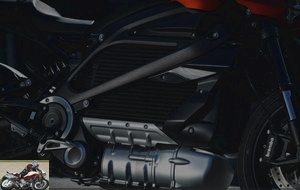 The 15.5 kWh Lithium ion battery pack
The 15.5 kWh Lithium ion battery pack
The SFF-BP Showa fork impresses with its 43mm diameter because the bike is low (761mm seat height). The shock absorber, also Showa (BFRC), is hydraulically adjustable and preloaded. The tires, of classic size, 120 wide at the front and 180 at the rear, were specially developed for the LiveWire by Michelin, Scorcher Sport. Brembo equips the braking part, with monobloc four-piston calipers in front.
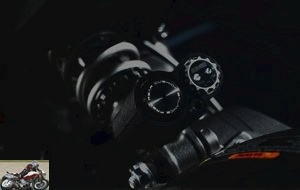 The Showa BFRC-lite rear shock absorber is adjustable
The Showa BFRC-lite rear shock absorber is adjustable
Rather rare sports equipment at Harley. Finally, electronics are essential: ABS of course, traction control, anti-wheeling, a rear wheel lift control system during braking (!) And residual torque control. All managed by a Bosch six-axis IMU inertial unit. Let’s go ?
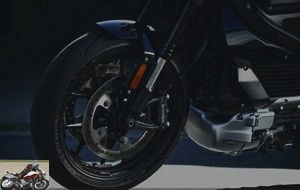 The LiveWire is fitted with Michelin Scorcher ‘Sport’ tires
The LiveWire is fitted with Michelin Scorcher ‘Sport’ tires
ok, we talked technical. But what I remember, me, is that compared to a lot of frankly ugly electric models, Harley-Davidson has managed to offer a model that looks like a motorcycle, a real one and not just a cubi or a big battery with bits of motorcycle around.
In the saddle
A key with transponder remains under the saddle or in the pocket, classic at Harley, pressing it activates the system, another on the right stalk starts the engine. The beautiful, thin, narrow but crisp TFT display reveals data that I will decipher later. The bottom line: speed and the charge indicator. Several engine modes are available, which vary the response to the grip, the torque curve, the intervention of the traction control and regeneration, that is to say, the recharging of the battery once the grip is on. »In off. I’m going in Road mode, which consumes less energy than the Sport and less anemic than the Rain (rain). Three other modes (A, B and C) make it possible to adjust each of the parameters mentioned on demand. The first silent laps are always a bit disconcerting. The troop of testers enters the first line of cars, we do not pass between the lines in the United States ….
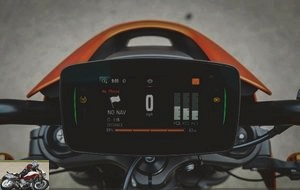 The LiveWire receives a 4.3 inch color TFT screen
The LiveWire receives a 4.3 inch color TFT screen
The seat is very low, my two feet are on the ground (I am 1m68). The driving position is somewhat reminiscent of that of the Ducati Diavel, with a low saddle, flat handlebars high enough in relation to the saddle and an almost upright seat, or barely leaning. On the other hand, the hollowed-out saddle does not allow you to change position. As for the passenger seat, it is rather decorative given its finesse. The bike quickly attracts sympathetic glances from motorists, who find it difficult to make the connection between the Harley lettering on the tank and the reigning silence. The first cleared lane after a red light becomes a drag strip and things are moving! The usual, frustrated senses (sight of the tachometer, sound of the engine) are replaced by others, more internal, such as the sensation of being pushed by the air which pushes the torso, or the nerve endings of the buttocks…. These sensations evoke those experienced on board simulators, such as Sebastien Loeb at Futuroscope, with sensors, visual mask etc. Funny how one technique called for the future calls for another, as if they merged towards obvious "progress".
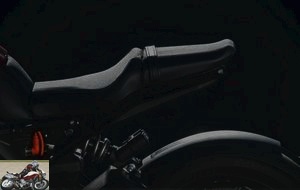 The saddle is perched 780 mm high
The saddle is perched 780 mm high
In the city
It is true that it is a pleasure to move about the city in almost silence, apart from an ultra high-pitched whistle which must scare away the cats…. The pleasant riding position, the low saddle, the flat handlebars, the beefy but manageable torque, the LiveWire could be an urban ideal if it was less heavy when stationary and if it had a smaller turning radius. Another drawback is the total lack of practicality. And I can’t imagine a top box on that. Under the saddle, the charging cable, two meters long, takes up space. On the other hand, it shows a lot, because the bike is pretty, very well finished. The side stand can be easily unfolded thanks to the clever lug. According to engineers, the motorcycle consumes less in the city than on the road and can travel more than 200 km in an urban environment. Because, unlike thermal, it does not use up energy when it is stopped. The handling is reminiscent of a big roadster.
 Harley-Davidson LiveWire test drive in town
Harley-Davidson LiveWire test drive in town
Departmental
Portland recedes in the retro, typical American roads split with a yellow line open to LiveWire. Considering the torque and the acceleration capacity guessed in town, I can’t wait to do battle. But up front, a guy from Harley riding what looks to me like a messy Road King Classic. He rubs in every turn, posed. The LiveWire’s ground clearance is arguably the best in the entire Harley lineup. The trick is to stretch the line to leave room.
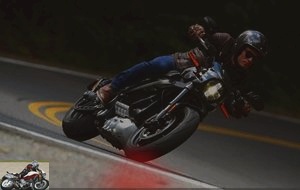 The Harley-Davidson LiveWire on the small roads
The Harley-Davidson LiveWire on the small roads
First braking a little tough, the big fork cash easily but lets see its low travel (115 mm says the technical sheet). Disadvantage of a low motorcycle…. Stability in curves is no problem, the LiveWire is precise and reassuring. As the kilometers go by, confidence grows and, deprived of classic benchmarks, I often find myself entering corners quickly. Without engine braking (in sport mode, the engine brake depending on the mode and energy recovery), without downshifting gears, you have to learn everything again. However, the error then consists in taking the front brake slightly and putting even more stress on the tire, which is already well bevelled. The LiveWire also tends to straighten up, as on motorcycles where the front axle lacks hunting or where the column angle is too closed. The values indicated seem classic (24.5 ° for the column, 108 mm for the flush)…. Perhaps this is due to a somewhat "one-piece" weight distribution, because of the engine / battery assembly…. Without going that far, this behavior reminds me a little of the Buell XB12S (we stay at Harley’s suddenly), with its very closed column angle. It’s hard to really pinpoint the origin of this reaction in such a short time. It can also come from the classic reflexes of the motorcyclist so accustomed to thermals that I am, who tends on the road to brake too much in the bend with the engine brake and gradually re-gas halfway through the curve. On the contrary, the LiveWire loves not being subjected to any constraint in bends, so you have to keep speed on entry, dose it cleverly so as not to have to destabilize it with the brake and go out like a bullet thanks to the omnipresent torque..
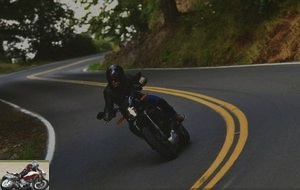 Sequence of turns with the Harley-Davidson LiveWire
Sequence of turns with the Harley-Davidson LiveWire
At the first stop, I enter the dashboard menu and choose A mode, custom. I put the torque at 100%, so available even more than in Sport mode and the response to the grip at the same level. The motorbike turns into a fearless little catapult, it kills! However, there again, I lack the benchmarks to accelerate correctly out of a corner, deprived of noise. Everything has to be learned again and this is the greatest benefit of electric motorcycles: opening up a new horizon in the practice of motorcycling. It would be ideal for learning to ride the circuit, where entry speed is more difficult to acquire. A shame for a Harley.
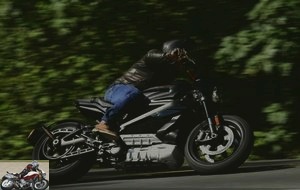 Fast curve with the Harley-Davidson LiveWire
Fast curve with the Harley-Davidson LiveWire
A hundred miles after touring the depths of Oregon, my driving has already changed. Magic of paradoxes, the electric motorcycle likes fluid driving. On a winding road, it reminds me of a ski descent. All you think about is the braking and the trajectory, in an almost restful silence. What is not, however, is the saddle. I felt it after about 80 km. It lacks padding and its hollow blocks the position of the lower back.
 The Harley-Davidson LiveWire in a curve
The Harley-Davidson LiveWire in a curve
Highway
Harley’s planned route did not use a freeway. But I can deduce from the 130 km traveled that the saddle will quickly require frequent stops, that protection is obviously non-existent but that the stability will be royal. Anyway, at 130 km / h stabilized, for sure that the motorcycle holds 1h30 of charge ….
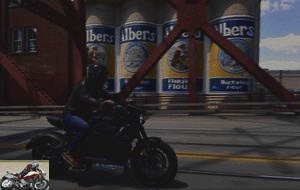 The Harley-Davidson LiveWire in a straight line
The Harley-Davidson LiveWire in a straight line
Part-cycle
LiveWire is healthy, stable, moderately agile. Its suspensions withstand progressively the defects of the road and the onslaught of braking and acceleration, which braking does not attract any reproach. You can quickly have fun with LiveWire, as long as you understand its behavior and change the way you drive, without the usual cues. There remains this tendency to get up when cornering when the front axle is forced.
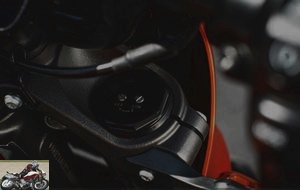 The Showa SFF BP inverted fork is adjustable
The Showa SFF BP inverted fork is adjustable
Braking
I just mentioned it, it’s as powerful as it is progressive. The rear is often used, precisely to slow down in turns, it is dosed perfectly, a success.
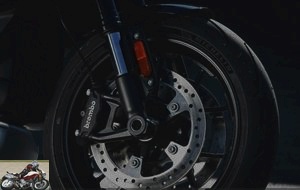 The front receives Brembo Monobloc 4-piston radial calipers
The front receives Brembo Monobloc 4-piston radial calipers
Autonomy
At the end of this test, the charge indicator showed 23% remaining charge after 65 miles, or 105 km. Of course, I drove a little hard, excited by the nervousness of the engine. The 200 km seem accessible, at the cost of frequent vigilance. I’d rather bet on 170 km in normal, relaxed use. There remains the problem of the terminals, which do not yet exist. The Fast Charge in an hour, at the dealership, seems unreal. It is therefore necessary to wait eight hours to regain full autonomy, which excludes long distances. But the cost of "full" is a dream, estimated at 3 euros !
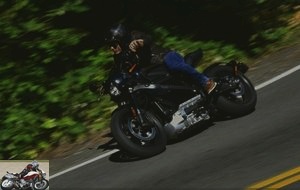 The range of LiveWire is approximately 150 km
The range of LiveWire is approximately 150 km
Video test
Conclusion
For the moment, electric motorcycles are confined to daily use that does not exceed 150 km. However, few people ride 150 km per day on a motorcycle, so driving LiveWire every day remains realistic. The price is dissuasive, for my purse in any case. Technology must eventually improve to store more energy in smaller batteries, because unlike cars, motorcycles have very little housing space. And it must be said that there has already been a lot of progress at this level in recent years (more autonomy, increasing top speeds and decreasing charging times).
We are talking about the end of thermal for 2040. We are therefore not ready to see electric replace thermal tomorrow. On the other hand, we can be delighted to see the arrival of other types of motorization on motorcycles, which create new pleasures of riding. LiveWire is placed exactly in this perspective. Its healthy balance, its discreet yet muscular engine, its exemplary finish shed new light on the misconception that one can have of an electric motorcycle. But will it be able to persist without commercial success? Unless, as in the 1910s, the police forces of the various American states place orders with Harley ….
The downsides, starting with the price and the biker’s conceptual reluctance to electric, are too numerous for LiveWire to democratize electrics at the moment. But if this is all about use, then LiveWire is both a revelation and a revolution in Harley history. At least she will stay for that. And it will be able to seduce those who want a real Harley but without the noise … while waiting for the next electric models of the brand, announced as lighter and cheaper..
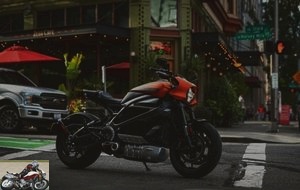 Harley-Davidson LiveWire
Harley-Davidson LiveWire
Strong points
- Engine couple
- Finishing
- Curve stability
- Silence
- Braking
Weak points
- Price
- Recharge (where? How? Etc.)
- Front axle a little sensitive to attack
- Uncomfortable saddle
The Harley-Davidson LiveWire technical sheet
Test conditions
- Itinerary: town, various back roads in Oregon
- Weather: Dry weather, temperature around 25 °
- Motorcycle mileage: 400 km
- Mileage: 105 km
Pilot equipment
- X Lite X 201 Ultra Carbon Helmet
- Spidi Garage Jacket
Related articles
-
Under high voltage 0 to 100 km / h in 4 seconds Harley-Davidson invited us to the Michelin circuit in Ladoux to test its “Project Livewire” electric…
-
Zero SR / F electric motorcycle test
Showtime ! Electric motor with 110 hp and 190 Nm, 220 kg, 200 km / h, from 20,690 euros Today, there are two main families of motorized two-wheelers…
-
Harley-Davidson VR 1000 motorcycle test
The first American superbike 60 ° V-Twin of 996 cm3, 135 hp and 107 Nm, 177 kg, 50 units produced 1995! 25 years ago! This date is a major milestone for…
-
MV Agusta Superveloce 800 motorcycle test
Neo-retro in the right tempo 3 cylinders of 798 cm3, 148 hp, 88 Nm, 173 kg, 20,300 euros Concept bike adapted in an ultra exclusive limited series, the…
-
Biker test: David B. At first look the BMW R1150R serves a design combining class and sobriety. The lines are more worked than on the old R1100R and the…
-
Kawasaki Versys 1000 S Grand tourer motorcycle test
Daily test for fifteen days 1,043 cm3, 120 hp at 9,000 rpm, 102 Nm at 7,500 rpm, 257 kg, 15,099 euros (17,099 euros Grand Tourer version) This bike, to…
-
Super Soco CPx electric scooter test
Daily test of the equivalent model 125 with two batteries 160 km of autonomy announced, 90 km / h, 4,000 watts, 171 Nm, 115 kg, 5,290 euros If there is…
-
Ducati Multistrada 950 S motorcycle test
Time concordance A few generations of bikers have dreamed of the ultimate bike, one that adapts to context and mood, needs and desires. As our ancestors…
-
Harley-Davidson Road King ‘107’ test
New 8-valve Milwaukee-Eight engine for this queen of the road 1745 cm3, approx. 90 horsepower, 150 N.m at 3250 rpm, 361 kilos dry, from 24,490 € Here, a…
-
Benelli Imperiale 400 motorcycle test
EVO Classic 374 cc single cylinder, 21.1 hp, 29 Nm, 205 kg, 4,399 euros Benelli is the oldest existing brand in Italy. But we should no longer say…
I had a good time reading Cassoulet’s comment, yes, yes, already as a nickname it smells good of deep France, the one that innovates in the motorcycle and it is a good synthesis of the cliches concerning Harley but made with humor.
It is fashionable to bust Harley like we bust Brough or Midual, we do nothing, we criticize, we move the lines, we criticize.
Bearded, non-bellied and water-drinking scandal, I will not be a buyer but I recognize that they dared, in these times of unique thought and Chinese copy. It will surprise purists and targets a different clientele, a super square at Harley, the revolution, and more with nags.
The style is debated because of the Day Maker lighting more comfortable on a touring but it brightens. I had a Honda that lit up nothing.
I do 700 miles in Harley without having recourse to an osteopath and I take more luggage than my b *** and my knife and if I take stock, apart from the tires, it does not cost too much in maintenance.
Between her and a GS with 22,000 balls that we cross at every street corner, I will show a certain originality and no one has ever commented on my Harley in my presence, rather compliments.
This plastic design, worthy of a ride-on mower, to the rescue … And this price! They are not ready to rejuvenate their clientele and go up the slope. (For those who don’t know, Harley is getting worse and worse. Unlike Indian).
Harley has been dying for several years, trapped by the image they themselves forged in the 80s. Stuck with an aging and conservative clientele who want rocker arms, cylinder fins, and "potatoes-sound" . I work right next to the HD concession in my department: on big days, it looks like a club for pre-retirees! You are looking for the under 50s !
A simple, agile and elegant machine with a little chrome, scrambler style, а 12000 E. This is what they need to project themselves after the "boomers".
A modern interpretation of black & white photography.
Long before "easy rider" and its folklore.
The difference between Harley and the others starts with their forum (Harley passion) very revealing of a ridiculous mentality: To register you must necessarily have
A Harley!
Superb writing for this article, which is particularly interesting. !!!
What a "special" machine, to say the least. Aesthetically speaking, you have to get used to it, but why not basically, even if I am far from being a fan of HD ??? It must be said that the price offered for the interesting and original "standard" version, there is food for thought..
They took their SUV out of the Hummer motorcycle…
Well I expected there to be a Livewire version anyway
Well done C @ ssoulet!
For information, for the ignorant, a forum or a brand club brings together the owners of the brand, my poor eriko I can quote you the Gold Wing club, the BMW club, the Guzzi club, the Laverda club, the Terrot club or Motobecane, the Himalayan forum, in short, brand enthusiasts can join a brand club, the list is long.
We can not like a brand but find ridiculous arguments to treat others as ridiculous !!! It makes people laugh in the cottages.
And then as if the age were crippling, to believe that you do not all age as much as you are..
Because on a Versys there is no plastic? The privilege of a retiree is to have free time, will reviving finned engines or continuing to keep them alive become prohibited or unhealthy thinking??
Criticize but with humor like cassoulet.
I have had all types of machines but I have rarely seen so much nastiness and animosity towards this brand, to believe that there is a feeling of frustration in some.
I reassure you, we take advantage of it like old people, we repair bikes that we roll and the rest we do not care.
I agree with Picabia on his analysis, as this brand seems to crystallize all the criticisms, we can not like but we can also remain impartial !
so yes Harley is bad, so yes the design is divisive, so yes it will not be for everyone but at least they offer a motorcycle differentiating from the others, whether compared to their own models or to those of the competition !
I say bravo for the industrial approach and the questioning, obviously HD could not wait without trying anything by living on an image certainly exceptional but aging
I have never been a fan of HD (although having ridden a lot of Street Glide in other regions) because I considered these motorcycles not in tune with our French roads, I expected this since its presentation and this test confirms me in the merits of their proposal
the HD dealer in my region has a quota of 15 motorcycles, 7 of which are already sold firm to customers who have never had HD, including me 🙂
so yes I will not drastically drop the average age of HD owners but the price is reasonable for a machine with this level of equipment versus the German / Italian / Austrian and the dealer sees new customers interested in this machine, proof that the brand has succeeded …
To have driven a Harley I don’t like. I don’t like Harleysts who on the WE dress up as bad boys with a wallet hanging from the jeans by a chain. I saw it with a scrap metal cup also at the end of a chain. The look that some people think is mandatory makes me laugh. On the other hand, some Harleys are beautiful, most Harleysts are nice (more than the behemist who always refuses to make a sign when you meet him). Some Harleys are ugly just like any builder.
We love we don’t love, but out of pity write with impartiality and not out of jealousy or other resentment
Excellent cassoulet text! V
And what about maintenance? How many visits? Generally maintenance on Harley Davidson is quite expensive what about this model with this new engine?
As stated in the test you read: every 8,000 km.
In principle, the valve clearance is corrected automatically.
The weight, again the weight, the old people don’t like the weight, it’s heavy .
Mechanical dinosaurs just found their totem pole
Nice shot of venom spat on this bike. I imagine the designers of HD stole your taste a few years ago..
We like it or we hate it, but hey, there’s no point in going any further in the pettiness.
I like the style, it’s a change from the GS and it could well be my next bike if the 2022 vintage addresses this issue of maintenance intervals (8,000km for a bike made for traveling, I think that’s a real shame).
Without wanting to advance me the interval of 8000 will not change.
In particular, the oil is highly stressed and participates in the distribution by the automatic adjustment of the valve clearances, the air-cooled engine heats up quite a bit and the oil deteriorates..
It is therefore necessary to have an oil of constant viscosity, hence the oil change every 8000. On the penultimate engine there is an oil cooling system in the upper engine..
The last motor has a more open angle and liquid cooling but the frequency does not change, mystery.